Sumpter Valley Attractions
</b>
Sumpter Valley Attractions
 Sumpter Valley lies along the Powder River East of Baker City in Eastern Oregon. The small town of Sumpter with a current population of just over 150 people was once the second largest city in Oregon during the Northeastern Oregon gold rush in the 1890's. In 1897, Sumpter had a population of about 300. Six years later in 1903, the population had swelled to almost 4,000. It was world famous as "Golden Sumpter," and boasted hotels, saloons, three newspapers, a smelter an opera house, and a hospital. It is much quieter now except during the flea markets on Memorial Day, Fourth of July , and Labor Day Weekends. Then the town swells to several
Sumpter Valley lies along the Powder River East of Baker City in Eastern Oregon. The small town of Sumpter with a current population of just over 150 people was once the second largest city in Oregon during the Northeastern Oregon gold rush in the 1890's. In 1897, Sumpter had a population of about 300. Six years later in 1903, the population had swelled to almost 4,000. It was world famous as "Golden Sumpter," and boasted hotels, saloons, three newspapers, a smelter an opera house, and a hospital. It is much quieter now except during the flea markets on Memorial Day, Fourth of July , and Labor Day Weekends. Then the town swells to several 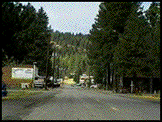 thousand people selling and browsing through the various offerings. The rest of the year is filled with the sounds of the residents and campers from nearby campgrounds enjoying the great food offerings from local business, as well as belted kingfishers and wild ducks on the ponds in the tailing piles.
thousand people selling and browsing through the various offerings. The rest of the year is filled with the sounds of the residents and campers from nearby campgrounds enjoying the great food offerings from local business, as well as belted kingfishers and wild ducks on the ponds in the tailing piles.
When driving through the Sumpter Valley, large amounts of raised gravel and rocks on the valley floor seem unnatural compared to the beauty of the surrounding Blue Mountain pine forest. It has been over 40 years since the last dredge chewed and groaned through the farm land along the Powder River and the plants are beginning to hide the evidence of this massive disruption. It is 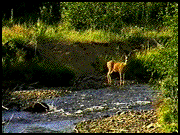 evident that nature is resilient as the small ponds left by the dredges are home to deer, beaver, waterfowl, fish, and a large variety of interesting plants.
evident that nature is resilient as the small ponds left by the dredges are home to deer, beaver, waterfowl, fish, and a large variety of interesting plants.
Sumpter Valley Dredge State Heritage Area
The Sumpter Valley Dredge State Heritage Area encompasses about 80 acres of tailing piles and is the final resting place of Sumpter Valley Dredge #3. When the State of Oregon assumed control of the site in 1993, the dredge was is desperate need of renovation. It was unsafe for the public to tour and it appeared that it was no longer floating. Oregon State Parks and Recreation staff has developed a plan to repair the dredge and reopen it to the public for tours. Although renovation funding is not complete, the dredge was floated in the summer of 1995.
The Friends of Sumpter Valley Dredge, a non-profit organization was formed in 1992 to promote the park and to raise funds for interpretive exhibits. The Friends operate a gift shop on the site with information about the dredge.
They are currently raising money for:
- Phase 1- Museum/Store /Office building fund;
- Phase 2- Publication of brochures;
- Phase 3- Supplemental Dredge Work.
To join the Friends of Sumpter Valley Dredge, phone 541-894-2433 or write P.O. Box 518 Sumpter, Oregon 97877-0451. Annual dues start at $20.00 for individuals and $40.00 for family memberships.The Sumpter Valley Railroad Restoration, Inc., a non-profit civic historical enterprise, operates a temporary depot on the site that serves as the west end of the line. They are planning to build a permanent depot/interpretive center and to extend the track to include a loop around the site.
Sumpter Valley Dredge #3
Dredge #3 was built at a cost of approximately $350,000 in 1935 about 2 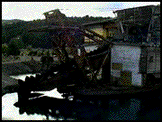 miles from its present location. It operated from 1935 until 1954. It was constructed using machinery salvaged from Dredge #1 the remains of which can be found across the rail road tracks from the McEwen Station Depot. Dredge #3 extracted more placer gold than any other Oregon dredge, a reported $4.5 million at the price of $35 per ounce.
miles from its present location. It operated from 1935 until 1954. It was constructed using machinery salvaged from Dredge #1 the remains of which can be found across the rail road tracks from the McEwen Station Depot. Dredge #3 extracted more placer gold than any other Oregon dredge, a reported $4.5 million at the price of $35 per ounce.
Dredge #2 was the smallest of the Sumpter Valley dredges as it was designed to operate in Cracker Creek which is in a narrow valley just west of Sumpter. The remains of Dredge #2 may still be seen along the creek today beside the road to Bourne. The machinery from this dredge was shipped to Alaska to be used in a new dredge.
Dredge #3 was the largest of the three dredges in the Sumpter boasting a bucket line with 72 one ton buckets each holding 10 cubic yards of material. The bucket line rotated at a speed of 25 buckets per minute. The dredge hull measures 52x 120x11 feet and the stacker is 96 feet long.
 Operating the dredge required astonishing amounts of power and water. The power came from the Fremont Power Station located between Granite and Olive Lake. A large wooden pipeline carried water from Olive Lake to the power station. Enough electricity was generated to power the towns of Granite and Sumpter as well as serve the needs of the dredge. A portable substation mounted on a truck fed out 12 miles of a 23,000 volt line that ran the 250 horsepower engine which
Operating the dredge required astonishing amounts of power and water. The power came from the Fremont Power Station located between Granite and Olive Lake. A large wooden pipeline carried water from Olive Lake to the power station. Enough electricity was generated to power the towns of Granite and Sumpter as well as serve the needs of the dredge. A portable substation mounted on a truck fed out 12 miles of a 23,000 volt line that ran the 250 horsepower engine which 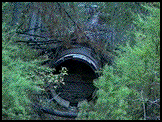 turned the bucket line.
turned the bucket line.
As Steve Alford, Park Ranger, joked, "It was just like a giant toaster!"
The raw material was fed in through the bucket line to a huge trommel, a big cylinder with 3/4 inch holes in it. As the trommel turned, the smaller material sifted through the holes into the sluice boxes. The dredge required three thousand gallons of water per minute to settle the gold in the six 24 inch jigs and the sluice boxes. The larger material that passed through the trommel without sifting out the small holes went up the stacker, a large conveyor belt, and out onto the tailing piles.
Sumpter Valley Railway
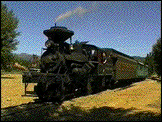 The Sumpter Valley Railway linked the people and enterprises of northeastern Oregon's Blue Mountain region for fifty years. It was started in Baker and followed the route of the Powder River up to the Sumpter Valley where it crossed the Blue Mountains to Prairie City (almost to John Day). The narrow gauge railroad was conceived to haul quartz and lumber. The gold strike on Cracker Creek in the late 1880s made the rail line more profitable than was ever conceived.
The Sumpter Valley Railway linked the people and enterprises of northeastern Oregon's Blue Mountain region for fifty years. It was started in Baker and followed the route of the Powder River up to the Sumpter Valley where it crossed the Blue Mountains to Prairie City (almost to John Day). The narrow gauge railroad was conceived to haul quartz and lumber. The gold strike on Cracker Creek in the late 1880s made the rail line more profitable than was ever conceived.
In 1946, the tracks were abandoned. In 1970, the Sumpter Valley Railroad 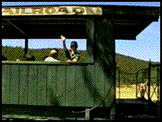 Restoration, Inc. group was formed. Now, they operate one of the original steam locomotives and several rail cars on weekends from Memorial Day Weekend through the last weekend of September.
Restoration, Inc. group was formed. Now, they operate one of the original steam locomotives and several rail cars on weekends from Memorial Day Weekend through the last weekend of September.
For more information about schedules or to join the SVRR group, phone 541-894-2268 or write SVRR, Inc., P.O. Box 389, Baker City, Oregon 97814.
Click here to find out about Sumpter Valley videos.
Click here to go back to the index.

.
 thousand people selling and browsing through the various offerings. The rest of the year is filled with the sounds of the residents and campers from nearby campgrounds enjoying the great food offerings from local business, as well as belted kingfishers and wild ducks on the ponds in the tailing piles.
thousand people selling and browsing through the various offerings. The rest of the year is filled with the sounds of the residents and campers from nearby campgrounds enjoying the great food offerings from local business, as well as belted kingfishers and wild ducks on the ponds in the tailing piles. evident that nature is resilient as the small ponds left by the dredges are home to deer, beaver, waterfowl, fish, and a large variety of interesting plants.
evident that nature is resilient as the small ponds left by the dredges are home to deer, beaver, waterfowl, fish, and a large variety of interesting plants.  miles from its present location. It operated from 1935 until 1954. It was constructed using machinery salvaged from Dredge #1 the remains of which can be found across the rail road tracks from the McEwen Station Depot. Dredge #3 extracted more placer gold than any other Oregon dredge, a reported $4.5 million at the price of $35 per ounce.
miles from its present location. It operated from 1935 until 1954. It was constructed using machinery salvaged from Dredge #1 the remains of which can be found across the rail road tracks from the McEwen Station Depot. Dredge #3 extracted more placer gold than any other Oregon dredge, a reported $4.5 million at the price of $35 per ounce. Operating the dredge required astonishing amounts of power and water. The power came from the Fremont Power Station located between Granite and Olive Lake. A large wooden pipeline carried water from Olive Lake to the power station. Enough electricity was generated to power the towns of Granite and Sumpter as well as serve the needs of the dredge. A portable substation mounted on a truck fed out 12 miles of a 23,000 volt line that ran the 250 horsepower engine which
Operating the dredge required astonishing amounts of power and water. The power came from the Fremont Power Station located between Granite and Olive Lake. A large wooden pipeline carried water from Olive Lake to the power station. Enough electricity was generated to power the towns of Granite and Sumpter as well as serve the needs of the dredge. A portable substation mounted on a truck fed out 12 miles of a 23,000 volt line that ran the 250 horsepower engine which  turned the bucket line.
turned the bucket line.  The Sumpter Valley Railway linked the people and enterprises of northeastern Oregon's Blue Mountain region for fifty years. It was started in Baker and followed the route of the Powder River up to the Sumpter Valley where it crossed the Blue Mountains to Prairie City (almost to John Day). The narrow gauge railroad was conceived to haul quartz and lumber. The gold strike on Cracker Creek in the late 1880s made the rail line more profitable than was ever conceived.
The Sumpter Valley Railway linked the people and enterprises of northeastern Oregon's Blue Mountain region for fifty years. It was started in Baker and followed the route of the Powder River up to the Sumpter Valley where it crossed the Blue Mountains to Prairie City (almost to John Day). The narrow gauge railroad was conceived to haul quartz and lumber. The gold strike on Cracker Creek in the late 1880s made the rail line more profitable than was ever conceived.  Restoration, Inc. group was formed. Now, they operate one of the original steam locomotives and several rail cars on weekends from Memorial Day Weekend through the last weekend of September.
Restoration, Inc. group was formed. Now, they operate one of the original steam locomotives and several rail cars on weekends from Memorial Day Weekend through the last weekend of September.